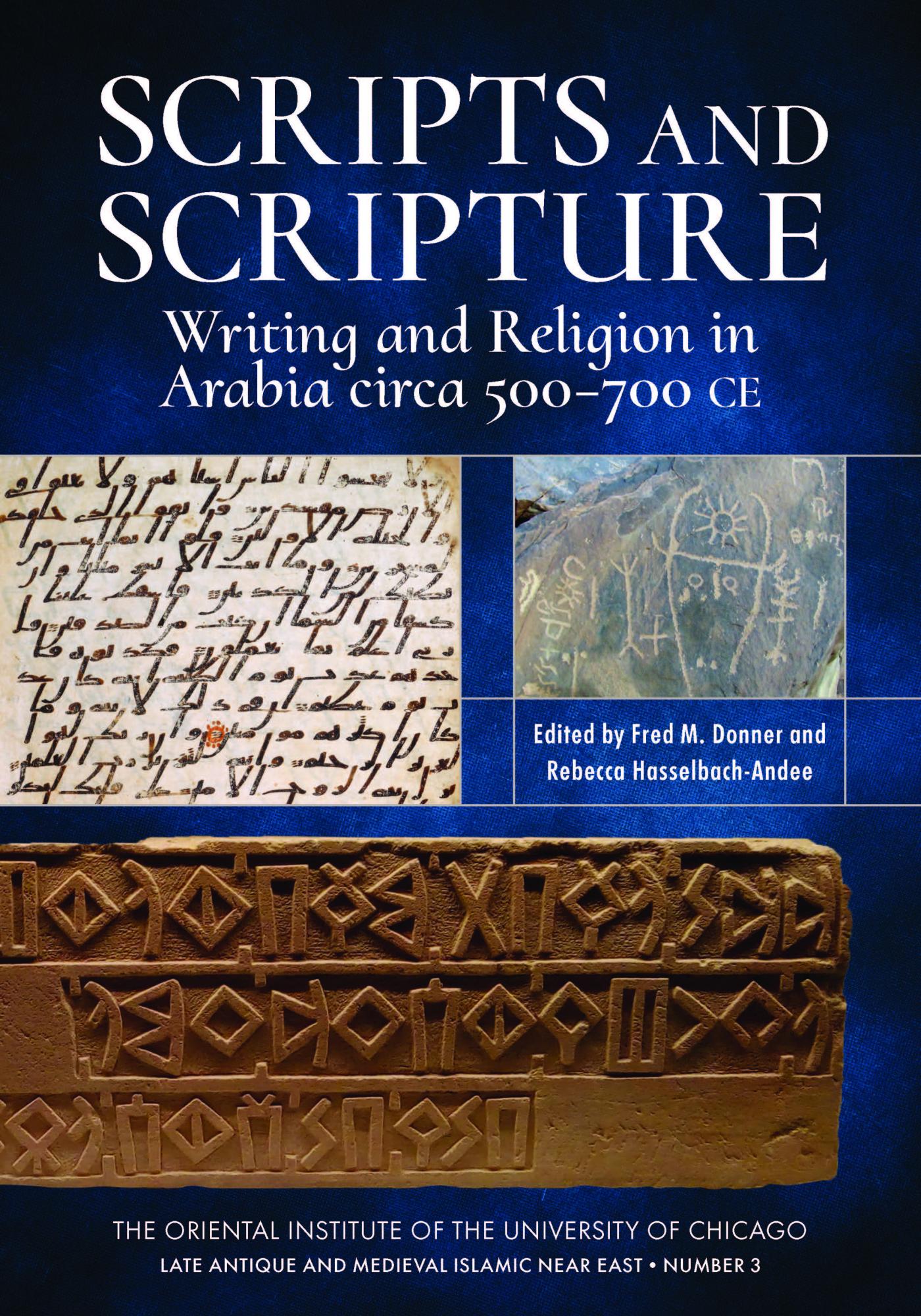Fred M. Donner and Rebecca Hasselbach-Andee, eds., with
contributions by Ahmad Al-Jallad, François Déroche, Fred M. Donner,
Suleyman Dost, Adam Flowers, Sidney Griffith, Robert G. Hoyland, Ilkka
Lindstedt, Kyle Longworth, Michael C. A. Macdonald, Laïla Nehmé, Gordon
Newby, and Hamza M. Zafer
Series Editors: Antoine Borrut and Fred M. Donner
How did Islam’s sacred scripture, the Arabic Qurʾān, emerge from
western Arabia at a time when the region was religiously fragmented and
lacked a clearly established tradition of writing to render the Arabic
language?
The studies in this volume, the proceedings of a scholarly
conference, address different aspects of this question. They include
discussions of the religious concepts found in Arabia in the centuries
preceding the rise of Islam, which reflect the presence of polytheism
and of several varieties of monotheism including Judaism and
Christianity. Also discussed at length are the complexities surrounding
the way languages of the Arabian Peninsula were written in the centuries
before and after the rise of Islam—including Nabataean and various
North Arabian dialects of Semitic—and the gradual emergence of the
now-familiar Arabic script from the Nabataean script originally intended
to render a dialect of Aramaic.
The religious implications of inscriptions from the pre-Islamic and
early Islamic centuries receive careful scrutiny. The early coalescence
of the Qurʾān, the kind of information it contains on Christianity and
other religions that formed part of the environment in which it first
appeared, the development of several key Qurʾānic concepts, and the
changing meaning of certain terms used in the Qurʾān also form part of
this rich volume.
Contents
List of Figures
List of Abbreviations and Sigla
List of Contributors
Maps of Arabia and Adjacent Regions
Introduction
1. Scripts and Scripture in Late Antique Arabia: An Overview. Fred M. Donner.
2. The Oral and the Written in the Religions of Ancient North Arabia. Michael C. A. Macdonald.
3. The Religious Landscape of Northwest Arabia as Reflected in the
Nabataean, Nabataeo-Arabic, and Pre-Islamic Arabic Inscriptions. Laïla Nehmé.
4. One Wāw to Rule Them All: The Origins and Fate of Wawation in Arabic and Its Orthography. Ahmad Al-Jallad.
5. ʿArabī and aʿjamī in the Qurʾān: The Language of Revelation in Muḥammad’s Ḥijāz. Robert Hoyland.
6. Scripture, Language, and the Jews of Arabia. Gordon D. Newby.
7. Script, Text, and the Bible in Arabic: The Evidence of the Qurʾān. Sidney Griffith.
8. Language of Ritual Purity in the Qurʾān and Old South Arabian. Suleyman Dost.
9. The Invention of a Sacred Book. François Déroche.
10. Script or Scripture? The Earliest Arabic Tombstones in the Light of Jewish and Christian Epitaphs. Kyle Longworth.
11. Religious Warfare and Martyrdom in Arabic Graffiti (70s–110s AH/690s–730s CE). Ilkka Lindstedt.
12. Writing and the Terminological Evolution of the Qurʾānic Sūrah. Adam Flowers.
13. The Adversarial Clansman in Qurʾānic Narrative and Early Muslim Antipatrimonialism. Hamza M. Zafer.
Bibliography
Index
- Late Antique and Medieval Islamic Near East 3
- Chicago: The Oriental Institute, 2022
- ISBN 978-1-61491-073-2
- Pp. xxii + 287; 55 figures, 10 tables, 2 maps
- Paperback 7 × 10 in
How did Islam’s sacred scripture, the Arabic Qurʾān, emerge from western Arabia at a time when the region was religiously fragmented and lacked a clearly established tradition of writing to render the Arabic language?
The studies in this volume, the proceedings of a scholarly conference, address different aspects of this question. They include discussions of the religious concepts found in Arabia in the centuries preceding the rise of Islam, which reflect the presence of polytheism and of several varieties of monotheism including Judaism and Christianity. Also discussed at length are the complexities surrounding the way languages of the Arabian Peninsula were written in the centuries before and after the rise of Islam—including Nabataean and various North Arabian dialects of Semitic—and the gradual emergence of the now-familiar Arabic script from the Nabataean script originally intended to render a dialect of Aramaic.
The religious implications of inscriptions from the pre-Islamic and early Islamic centuries receive careful scrutiny. The early coalescence of the Qurʾān, the kind of information it contains on Christianity and other religions that formed part of the environment in which it first appeared, the development of several key Qurʾānic concepts, and the changing meaning of certain terms used in the Qurʾān also form part of this rich volume.
Contents
List of Figures
List of Abbreviations and Sigla
List of Contributors
Maps of Arabia and Adjacent Regions
Introduction
1. Scripts and Scripture in Late Antique Arabia: An Overview. Fred M. Donner.
2. The Oral and the Written in the Religions of Ancient North Arabia. Michael C. A. Macdonald.
3. The Religious Landscape of Northwest Arabia as Reflected in the
Nabataean, Nabataeo-Arabic, and Pre-Islamic Arabic Inscriptions. Laïla Nehmé.
4. One Wāw to Rule Them All: The Origins and Fate of Wawation in Arabic and Its Orthography. Ahmad Al-Jallad.
5. ʿArabī and aʿjamī in the Qurʾān: The Language of Revelation in Muḥammad’s Ḥijāz. Robert Hoyland.
6. Scripture, Language, and the Jews of Arabia. Gordon D. Newby.
7. Script, Text, and the Bible in Arabic: The Evidence of the Qurʾān. Sidney Griffith.
8. Language of Ritual Purity in the Qurʾān and Old South Arabian. Suleyman Dost.
9. The Invention of a Sacred Book. François Déroche.
10. Script or Scripture? The Earliest Arabic Tombstones in the Light of Jewish and Christian Epitaphs. Kyle Longworth.
11. Religious Warfare and Martyrdom in Arabic Graffiti (70s–110s AH/690s–730s CE). Ilkka Lindstedt.
12. Writing and the Terminological Evolution of the Qurʾānic Sūrah. Adam Flowers.
13. The Adversarial Clansman in Qurʾānic Narrative and Early Muslim Antipatrimonialism. Hamza M. Zafer.
Bibliography
Index
- Late Antique and Medieval Islamic Near East 3
- Chicago: The Oriental Institute, 2022
- ISBN 978-1-61491-073-2
- Pp. xxii + 287; 55 figures, 10 tables, 2 maps
- Paperback 7 × 10 in






No comments:
Post a Comment